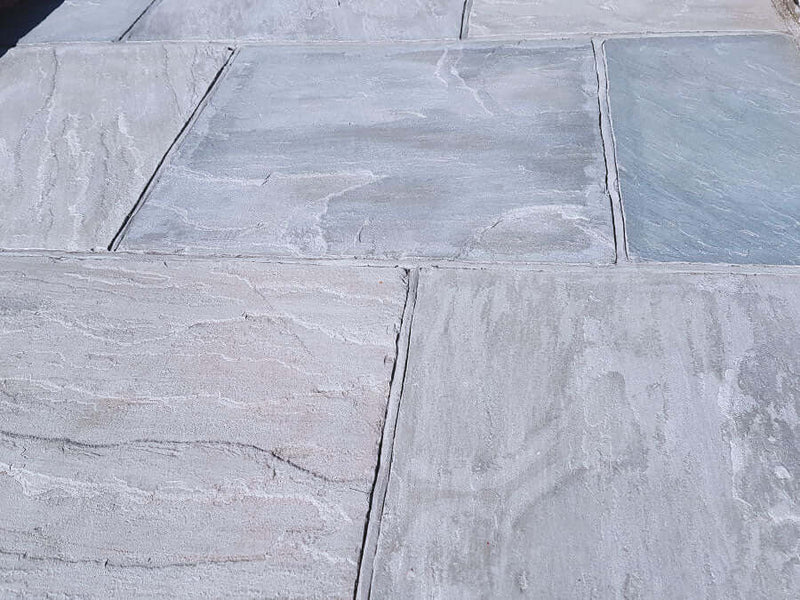A Guide To Indian Sandstone: All You Need to Know About Indian Sandstone Paving
This superb natural stone gives a space a rustic charm without costing the earth, so it’s no wonder Indian sandstone is such a popular choice for paving in gardens, patios and pathways. What’s more, it comes in 3 unique finishes, Bronte, Kandla Grey, or Mint
Read on for our complete guide to making the most of this prestigious, gorgeous-looking material.

What is Indian sandstone?
Indian sandstone formed millions of years ago in extreme heat from quartz grains which naturally become cemented together. India’s varied geology gives the stone a naturally veined look, so no two slabs of Indian sandstone are identical.
As with other types of sandstone, this version formed from beds of sand under the sea or in low-lying areas. When these subside into the earth’s crust, overlying sediments press them down, before minerals crystallise around the sand grains, fusing them together to create the sandstone.

Where does Indian sandstone come from?
This natural sandstone comes from India, a leading nation in the mining and export of sandstone. More than 90% of its deposits are found in the northern state of Rajasthan. However, there are also reserves in other regions including the Punjab, Uttar Pradesh, West Bengal and Tamil Nadu.
What are the benefits of using it?
-
Durability
Thanks to its high proportion of quartz crystals, Indian sandstone is hardwearing, plus its colours don’t fade. Not only will it withstand whatever the great British weather throws at it without cracking, but it can also tolerate the pressure of being walked or driven over daily, even with quite heavy foot traffic.
This stone also absorbs water less than comparable paving slabs, so it’s better at resisting frost and staining.
-
Non-slip
There’s a non-slip quality to this material, meaning that, even in wet conditions, you won’t be sliding and skidding around.
-
A stunning appearance
The way Indian sandstone was formed gives it its uniquely striking, attractive pigmentation. Additionally, there are many colours, finishes and tonal variations to choose from. And because it won’t fade, it remains attractive. The appearance is warm and vibrant, while the quartz crystals give it a glassy, shiny look and a clean, smooth surface.
If you use it in a driveway, its smart appearance adds to what estate agents call ‘kerb appeal’, or the first impressions someone has when viewing a property’s exterior.
-
Affordability
Compared to other kinds of sandstone, the Indian version is cost-effective. Clearly this is important for larger driveways or patio areas, and it’s a key factor behind its enduring popularity.
In particular, riven sandstone is especially affordable, without compromising quality. This kind of surface is created naturally as the stone splits across its natural layers, giving it an authentic finish with textural variations across each slab’s surface.
-
Low-maintenance
Keeping Indian sandstone paving in decent nick doesn’t have to require huge amounts of time or effort. Cleaning is straightforward and, as mentioned, the slabs can handle rain and harsh weather. Assuming the paving is fitted properly, your stone shouldn’t become destroyed or damaged over time.
Does Indian sandstone stain?
It may be pretty stain-resistant, but it’s not totally immune to this problem. Bird mess, lichen, leaves, footfall and more can all (literally) leave their mark over time as they break down. You should also keep an eye out for liquid spillages, such as drinks, and clear these up immediately.

How to clean Indian sandstone
Luckily, this doesn’t have to be unduly complicated. The best way to clean this material is with soapy water. For tougher stains, including algae and moss, use a bleach mixture. Any product which has an acid content could rust the slabs, so avoid these, especially if you have any Limestone products within the area as this will cause irreversible damage to these types of stones.
Regular cleaning with warm soapy water is easy – just use washing-up liquid and a bucket. Sweep away superficial dirt and remove all furniture first. Pour your mixture over the sandstone, scrub thoroughly with a hard-bristled brush and rinse. Leave to dry for 24 hours. For more stubborn grime, staining, or blackspots, use one of our sandstone cleaners
If you’re choosing bleach, use it and water in equal measures and clean the slabs with a heavy-duty broom. Leave for 15 minutes before rinsing.
Can you jet wash Indian sandstone?
Yes, you can. In fact, a jet or pressure washer is the ideal way to clean this stone. But take care to use either a flat surface cleaner or a wide spray pattern. Because some sandstone can be soft, try not to use a pencil jet or a turbo on a high-pressure setting.
Keep the pressure on medium (between 1,200 and 2,000 PSI) to avoid damaging the surface of the material.
For stubbornly dirty sandstone, consider adding a specialist cleaning solution and rinse thoroughly afterward.
Is Indian sandstone porous?
Indian sandstone is indeed porous, or, as some say, permeable. So moisture penetrates the surface. Again, this means that correct installation is critical. However, sandstone’s permeability doesn’t make it unsuitable for driveways, patios or gardens – on the contrary! Due to the porous nature of sandstone, we would recommend applying a natural stone sealer to the surface. This can be completed after a couple of months once the stone has settled and bedded in. Sealing sandstone will assist in the general upkeep, stain resistance, and cleaning of this wonderful product.
